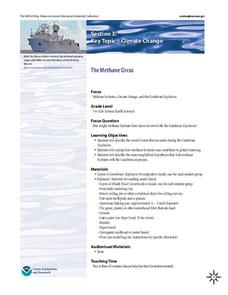Curated and Reviewed by
Lesson Planet
This The Methane Circus lesson plan also includes:
- Volume One: Why Do We Explore? Complete Book
- Framework Correlations
- NGSS Performance Expectations
- Burgess Shale Fossil Specimens
- Activity
- Worksheet
- Answer Key
- Graphic & Image
- Vocabulary
- Join to access all included materials
Step right up! An engaging research-centered instructional activity, the third in a series of six, has young archaeologists study the amazing animals of the Cambrian explosion. Working in groups, they profile a breathtaking and odd creature and learn about its role in creating the methane hydrate stores found in the deeps of the ocean.
4 Views
4 Downloads
CCSS:
Designed
Concepts
Additional Tags
Instructional Ideas
- Make a model of a methane hydrate molecule to give young learners a better idea of why it is unique
- Be prepared to assist with pronouncing animal names used in research; use the link provided in the guide for pronunciations and images
Classroom Considerations
- Schedule time in the school's computer lab so groups may research their animals
Pros
- Teacher's guide includes research notes worksheet and interesting extensions to the lesson
- Pupils can make inferences about evolutionary concepts when examining images of the animals for research and comparing them to animals that are alive now
Cons
- None


